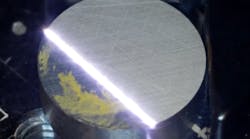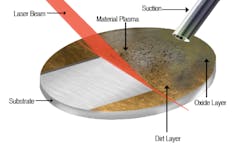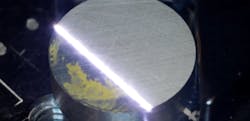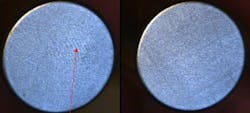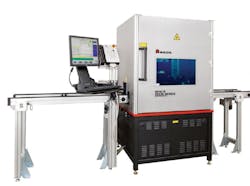Laser Cleaning Battery Connections Prior to Joining
An electric vehicle’s battery’s performance is only as good as the joints/connections between the cell and the tab. Further, the quality of that joint depends on the cleanliness of the parts. Such surface contaminants as grease, oil, and other corrosion-inhibiting agents used in manufacturing can lead to poor fusion, cracks, and joint porosity. That's why many battery manufacturers are turning to laser cleaning (also called laser ablation) to clean part surfaces prior to welding.
Fast, safe, and cost-effective, laser cleaning is especially important for meeting electric vehicle battery reliability goals that will enable electric vehicles to ultimately replace combustion engine-based automobiles.
Transportation and Handling Introduces Contaminants
Transportation and handling of batteries prior to the welding process introduces contaminants and allows oxides to form. This is especially true when batteries are coming from overseas and shipped by ocean freight.
Contamination on parts results in weak (or no) welds when joining tabs to cells in battery modules or pack manufacturing. In addition, contamination can result in reduced conductivity at the weld joints, ultimately limiting the battery pack’s overall performance. The contamination reduces performances and increases temperatures, leading to problems with the battery over the life of the vehicle.
These issues are an important challenge for electric vehicle (EV) manufacturers, which are shooting for much longer battery pack life. Wired Magazine reported on battery researchers working with an EV manufacturer who published a paper in The Journal of the Electrochemical Society describing a lithium-ion battery that “should be able to power an electric vehicle for over 1 million miles while losing less than 10% of its energy capacity during its lifetime.”
Contamination Within the Battery Joint Region Leads to Poor Quality Connections
An EV battery is often comprised of groups of single lithium-ion batteries formed into a battery pack. An assembly of battery packs then fits into a battery module. There are thousands of connections in any one electric vehicle battery module. For example, some models contain 7,000 batteries, with a minimum of 30,000 connections. If any one of these connections fails, it can create a problem.
A number of welding or bonding technologies are used for making a secure battery connection in EV batteries, including laser welding, resistance welding, MicroTIG welding, and ultrasonic wedge bonding. The wedge bonding process in particular is sensitive to contamination coming from other operations near the machines.
Originally performed by circuit board manufacturers inside a clean room, wedge bonding has recently been widely adopted for producing interconnects between cells. However, battery pack manufacturing is not done in a clean room and the existing wedge bonding process is prone to contamination. When parts are brought into the manufacturing area and assembled into a battery pack, the wedge bonding environment harbors floating contaminants that can cause a serious battery connection joint quality problem.
Surface Cleaning of Anode and Cathode Ensures High-Quality Welds
Cleaning of the battery anode and cathode (can/cap) can greatly improve the wire bonding/ welding process by creating an extremely repeatable surface for joining.
There are two primary methods used to clean batteries: media blasting (sandblasting or dry ice blasting) and laser cleaning.
Media blasting options use abrasives to literally rip contaminants off the surface of the part. While effective, these processes can also result in micro denting that can affect the finished product’s weld strength and appearance.
Laser cleaning removes contaminants at the weld joint while avoiding damage to the part and expulsion of hazardous debris. When used properly, laser cleaning will not mar the finished product. It is this ability to clean surfaces without damaging them that makes laser cleaning so effective at improving the overall process.
Laser cleaning works by focusing a laser onto a substrate to remove material on its surface. The amount of material removed depends on the intensity, pulse width, and wavelength of the laser, as well as the material itself which absorbs the laser light and breaks down the chemical bonds in the area. It can be achieved with either a pulsed nanosecond (fiber) laser or a continuous wave laser, although the former is more commonly used due to the high level of laser intensity. See Figure 1.
Laser Cleaning Benefits – Fast, Safe, Clean, and Cost Effective
Laser cleaning has many benefits over traditional media blasting methods like sandblasting and dry ice blasting which are time-consuming, inflexible, expensive, multi-step processes that also carry risks to the environment. Whether the manufacturer is using resistance welding, laser welding, or ultrasonic welding, using the laser cleaning process prior to welding significantly improves the process and quality.
Laser cleaning removes surface contaminants quickly and cleanly, reducing the need for downstream post-processing. Reports suggest that laser cleaning can be as much as 15 times faster than media blasting options. That means less time is spent cleaning products, and more time is available for producing them. Figure 2 shows the results of laser cleaning.
In addition, laser cleaning does not require abrasive blasting operations, which can create high levels of dust and noise. Studies indicate that sandblasting can cause silicosis, lung cancer, and breathing problems in exposed workers. By contrast, laser cleaning creates only a small amount of dust material removed from the part, which can easily be handled by fume extraction units. The operating laser and fume extractor are relatively quiet and do not need safety gear to dampen the sound.
The total cost of ownership of a laser is significantly less than that required for media blasting options.
Finally, laser ablation is easily integrated into an assembly line, so cleaning can be performed inline, immediately before the welding process. Other processes require parts to be sent out for cleaning in groups of a few hundred at a time, which means contamination could be re-introduced during transportation.
Examples of Laser Cleaning and Battery Welding
Figure 3 shows how laser cleaning can remove contamination from a battery can surface, significantly improving wire bond reliability. The image on the left shows the battery cell surface before laser cleaning and the image on the right shows the surface after cleaning. Figure 4 shows photos of a battery cell surface. The customer welded parts with and without fingerprints and performed a pull test.
The samples subjected to laser cleaning showed significantly improved weld strength. The image on the left shows the battery cell surface before laser cleaning. The red arrow notes a fingerprint on the surface. The image on the right shows the surface after cleaning; note the clean surface with no fingerprint.
Laser Cleaning Equipment Options
A variety of equipment can be used for laser cleaning in battery connection applications. Laser parameters are the key to the laser ablation process. By adjusting them, laser experts can optimize the laser process based on specific applications.
Many laser characteristics come into play when selecting the best-suited laser for ablation:
- Wavelength
- Pulse Length
- Beam Diameter
- Pulse Repetition Rate
- Beam Quality
- Scanning Speed
- Focal Distance
- Pulse Spacing
- Laser Power
- Number of Passes
Laser ablation typically uses high repetition rates and short pulses with high peak powers, as featured with a single-mode 20-watt Fiber Laser for instance, which is particularly suited for laser cleaning of alumina, silicon, copper, and aluminum foils. Additionally, fiber lasers tend to be more reliable and have better process reliability over time.
The laser will need to be integrated into a Class I, eye-safe workstation. Options might include an XY table, rotary stage, fume extraction, bar code reader, and camera systems to tailor the machine to specific processing needs.
Addressing the demand for inline manufacturing cells, consider a conveyor laser processing center which will allow for improved production efficiency and reduced operator interaction.
The conveyor laser processing center can be customized for inline laser cleaning operations.
Industry Moving to Laser Cleaning Process Prior To Joining Battery Connections
For EVs to replace combustion engine automobiles, the e-mobility industry must be able to produce reliable, high-quality battery packs. To improve quality and reduce costs, the industry is moving to laser-cleaning technology for pre-joining processes. The cleaner the surface, the better the connections.










